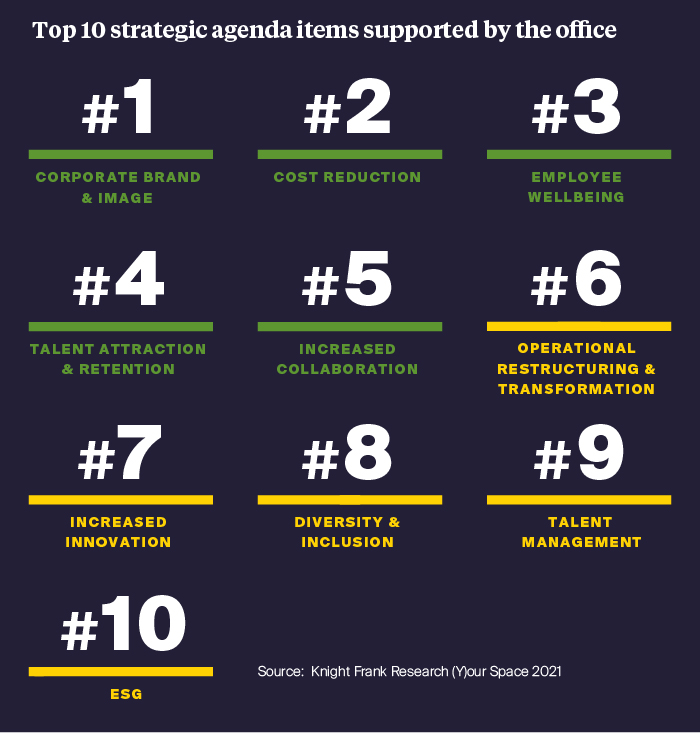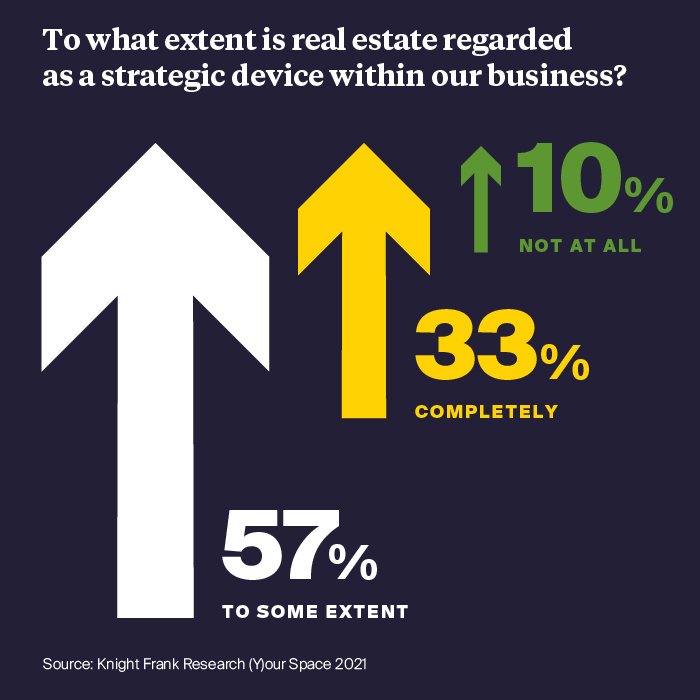Cultural connections
The views of almost 400 global occupiers confirm that the office continues to matter, but its form, function, quantum and qualities are set for transformation. Central to this transformation will be the use of the office as a device to galvanise corporate culture and generate stronger connections between employees.
6 minutes to read

Click to enlarge image
The challenges of the last 15 months have produced record levels of introspection in relation to the role offices will play in our post-pandemic working lives. Much of this forward-looking commentary has been revolutionary in tone. Yet, so little of it derives from the thoughts and opinions of real businesses or real estate decision makers. Knight Frank’s recently launched second edition of (Y)OUR SPACE addresses this analytical imbalance. Drawing on a survey of almost 400 global occupiers, with a combined global headcount of in excess of 10 million people, the research highlights the thinking that will shape the future form and function of the workplace.
From the perspective of the south east office market, the results provide an antidote to the sensationalism and, more importantly, a guide as to how offices will be perceived, utilised and configured over the next cycle.
The office still matters
When it comes to offices, the narrative of need has strengthened as the pandemic has progressed. As the honeymoon period for remote working drew to a close for many last autumn, and concerns about productivity and staff wellbeing increased, so too have calls from business leaders restating the case for the office.
Although there is recognition that the office may not be a fixed, five-days-a-week requirement, it has been firmly positioned as a valuable contributor to organisational culture, client interaction, staff development, recruitment and on-boarding, collaboration and socialisation. This tone is supported by our survey results. A total 90% of respondents regard the office as an important device that supports, facilitates or portrays business strategy – an increase on the 85% subscribing to this point of view in our original survey, back in 2018.
The office continues to matter to business. It matters because it supports a wide array of corporate agenda items. Indeed, our survey respondents identified ten specific business agenda items that real estate positively influences. Chief among these were corporate brand and image, cost optimisation and employee wellbeing.
The elevation of corporate brand and image and employee wellbeing as strategic items are particularly interesting barometers for the future function of the office. In a world of more flexible working styles, the office will take on greater prominence in promoting and galvanising the values and culture of the occupying business to their customers, clients and staff (both existing and prospective) – something that is undoubtedly difficult to achieve in a fully remote world with a highly dispersed workforce.
The office provides an identity and profile that is therefore invaluable commercially. It forges an interaction between people and property that serves to support and galvanise the culture, crucial to an authentic and cohesive brand position.
From collaboration to community
Greater interaction and collaboration is a key attribute of the office in a world where there will be greater flexibility and dispersal in where people work. The positioning of the office as a place where people come together is critical. On this basis, the office will need to be ever more compelling to its users. It will need to provide a reason for people to invest in their commute, both financially and psychologically. Consequently, we fully anticipate a further flight of occupiers towards high-quality, amenity-rich office environments.
Importantly, 47% of the occupiers we surveyed for (Y)OUR SPACE anticipate a further increase in the quality of the office space they occupy over the next three years. The same proportion expect an increased demand for building amenities that add to the allure of the office but also perform an important underlying function in supporting human connections and the creation of community within the workplace.
It is unlikely that any office building is capable of meeting the broad wish list of amenities sought by occupiers in response to the growing demands of employees. As a result, we believe there will be even greater attention paid to the locational choices made by occupiers. They will want to gravitate towards those locations that offer a richness of amenity outside of their immediate setting. In this regard, the recent regeneration of many south east centres will be attractive – creating a vibrancy, cohesion and connectivity that will be appealing to businesses both at this practical level but also in respect of wider corporate environmental, social and governance (ESG) ambitions – and particularly in relation to the “S” of social impact. Similarly, in business parks these same attributes of vibrancy, cohesion and connectivity will be in demand, and there is an opportunity here for owners to really address this through a thoughtful, active and customer-centric management regime that treats the park holistically rather than on a building-by-building basis.
The drive towards collaboration will also serve to reconfigure office design. A total 55% of respondents to the (Y)OUR SPACE survey anticipate an increase in the proportion of their office space that is given over to collaborative workplace settings over the next three years. Simultaneously, 31% are also expecting to decrease the amount of private or personal space their future offices provide. This again endorses the view of the office as a device to bring people together to interact, collaborate and, yes, to socialise. It makes the office a place founded on the principles of culture, connection and innovation rather than a place of isolation, individualism or administration.
Creating connections in a flexible, hybrid world
One of the failings of the debate about the future office over the last 12 months has been the inability to move beyond a binary view of the workplace, whereby the office and home are viewed as a simple either/ or choice. The realities have always been more complex and will be even more so after the experiences of the past year, which have proven that remote working is a valid approach for some people, for some tasks and for some of the time. The reality is that as we emerge from the pandemic, our relationship with the office (and hence our face-to-face interaction with colleagues) will be more fluid and flexible.
Workforces will be more dispersed as hybrid work styles take effect and hub-and-spoke occupational models potentially take hold. This will bring new challenges for occupiers. How do business leaders galvanise culture and create collaborative workplace communities in a world of greater dispersal? The risk of the inadvertent exclusion of those working remotely is high.
The experiences of the last 15 months have been telling. When enforced lockdown, and hence Teams and Zoom calls, was a reality for everyone, digital connection proved effective and robust. When those lockdown measures loosened, offices were partially reoccupied and, as a result, workforces become more dispersed between formal offices and remote workplace settings, so both the technological resilience and the effectiveness and inclusivity of such interactions became much more variable. This cannot be the experience going forward. As a result, we fully expect a greater demand for, and investment in, an important amenity – the high-end video-conferencing suite. This, together with strong and resilient digital connectivity, will enable the seamless interaction of those working in the office with those working remotely. Without it, the creation of coherent cultures and workplace communities, and the strategic business benefits they accrue, will become difficult to sustain.
